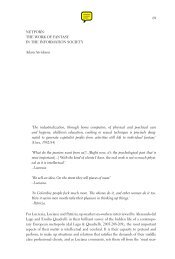Nakamura, Digitizing Race, Introduction, chapter 5, Epilogue
Nakamura, Digitizing Race, Introduction, chapter 5, Epilogue
Nakamura, Digitizing Race, Introduction, chapter 5, Epilogue
Create successful ePaper yourself
Turn your PDF publications into a flip-book with our unique Google optimized e-Paper software.
<strong>Epilogue</strong> 205<br />
the self online. The precrash discourse that posed virtual reality as an alternative<br />
to real life was replaced by one that cannily envisions identity online<br />
as a set of profiles, preferences, settings, and other protocols rather than a<br />
bona fide and understandably creepy “second self.” Cautions of Internet<br />
addiction have gone by the wayside since Web 2.0, for there is relatively little<br />
affective investment in online life posited here; tales of users getting married<br />
or living their “real” lives in online social spaces have withered away,<br />
casualties of a postmillennial acculturation to a new concept of virtual community<br />
that is less intensely focused on the Internet as a replacement for<br />
“real life.” Users no longer speak of VR and RL because they no longer feel<br />
as closely connected to their overtly fictional identities online. They just<br />
don’t identify with, or care about, their avatars as much as they once did.<br />
Yet at the same time, people of color and women care greatly about how<br />
they are visualized on the Internet. They care enough to sign protests about<br />
media racism, and when they don’t like what they see, they care enough to<br />
sign online petitions and perhaps even to sit down and create new some<br />
templates, new images of themselves, new databodies that talk back to the<br />
dominant. However, the tone I wish to take is cautiously optimistic and tells<br />
a story that is necessarily as much about social, economic, and technological<br />
constraint as it is about triumphant self-definition and self-determination.<br />
In a sense, the evolution of a pervasive graphical practice and culture on<br />
the Internet has come to resemble the visual culture of other media; finally<br />
there are enough producers of color and of colorful images on the Internet<br />
that one can legitimately speak of “black new media” just as one can speak<br />
of “black film,” “black art,” and “black theater.” In a sense, however, this<br />
merely signifies a repetition of the issues that plague the study of minority<br />
discourse in all visual cultures. Brave young Arab American women hacking<br />
their AIM buddies in their bedrooms are a sentimentally attractive image<br />
that fits into a classic narrative of rebellion and resistance against dominant<br />
new media cultures. The issue of a basically unthreatened material base for<br />
participation, unchanged technological protocols, unchallenged economic<br />
systems—in short, the pesky problem of protest within a system that one is<br />
nonetheless employing to frame the protest—continues to haunt the study<br />
of minority new media cultures. While avatars wearing chadors and DKNY<br />
sweaters certainly look different from more mainstream images of American<br />
femininity, and in fact contain a wealth of fascinating information that<br />
scholars and fans of hybrid cultures will greatly enjoy, they contain exactly<br />
the same number of pixels, are formatted in the same file type, and occupy the<br />
same amount of space in an IM screen as do all the others. Any deviation





